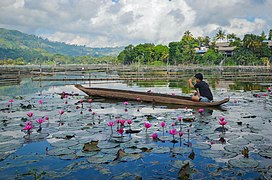| Lake Sebu | |
|---|---|
| Lanaw Sbù (Tboli) | |
 The lake taken at the Punta Isla Lake Resort | |
| Location | South Cotabato, Mindanao |
| Coordinates | 6°13′45″N 124°42′21″E / 6.22917°N 124.70583°E |
| Basin countries | Philippines |
| Surface area | 354 ha (3.54 km2) |
| Max. depth | 34 m (111.55 ft) |
| Surface elevation | 1,000 m (3,280.84 ft) |
| Islands | 11 islets/islands |
Lake Sebu (Tboli: Lanaw Sbù,[1] /sbuʔ/; Hiligaynon: Linaw sg Sëbu, /səˈbuʔ/; Filipino: Lawa ng Sëbu) is a natural lake located in the municipality of Lake Sebu, South Cotabato within the Alah Valley region.[2] The Philippine government has recognized it as one of the country's most important watersheds.[3] Lake Sebu is one of the many bodies of water supplying important irrigation to the provinces of Sultan Kudarat and South Cotabato.
The villages around the lake have been turned into an independent municipality called Lake Sebu after being a former village of Surallah.
Ancestral domain
[edit]The Tboli and Ubo tribes have been the traditional dwellers of the lake. The Department of Environment and Natural Resources has recognized, through Department Administrative Order (DAO) No. 2, Series of 1993, the claim of these tribes that the lake and its surroundings are under their ancestral domain.[4]
Tourism
[edit]The Department of Tourism and the local government unit of Lake Sebu has promoted the lake as one of the prime eco-tourism destinations in the municipality. The Mindanao Development Authority is closely coordinating with the DOT in the development and enhancement of Lake Sebu, as it is also identified as one of the priority sites under the BIMP-EAGA Tourism cluster.[5][6]
Gallery
[edit]-
Lake Sebu, as seen from Punta Isla
-
The lake is one of the most important watershed areas in the Philippines
-
Another view of the lake in South Cotabato.
-
Traditional owong dugout canoes in Lake Sebu
-
Indigenous people thriving near Lake Sebu
References
[edit]- ^ "Tboli Dictionary » Search Results » sbu".
- ^ Bagnol, Raquel C. (August 9, 2004). "Postscripts from Lake Sebu". Sunstar. Retrieved October 10, 2008.
- ^ Estabillo, Allen V. (September 26, 2008). "SouthCot moves to save Lake Sebu". MindaNews. Archived from the original on April 13, 2010. Retrieved October 10, 2008.
- ^ Logong, Datu Ontog. "Experiences and Challenges of the Indigenous People in Co-managing Forest Resources: The Lake Sebu Ancestral Domain Community Association". FAO. Retrieved October 10, 2008.
- ^ "SunStar: DOT pushes eco-tourism projects in Lake Sebu". GMA 7. June 3, 2007. Retrieved October 10, 2008.
- ^ "DOT pushes eco-tourism projects in Lake Sebu". Sunstar. June 3, 2007. Retrieved October 10, 2008.
External links
[edit] Geographic data related to Lake Sebu at OpenStreetMap
Geographic data related to Lake Sebu at OpenStreetMap- LakeSebu.com
- Lake Sebu Guide
- Lydia P. Oliva (1985). "Economics of Tilapia Cage Culture in Mindanao, Philippines". In Ian R. Smith; Enriqueta B. Torres; Elvira O. Tan (eds.). Philippine Tilapia Economics (PDF). Philippine Council for Agriculture and Resources Research and Development. pp. 83–106. ISBN 971-1022-18-4. ISSN 0115-4435.
- "The State of Fish in Nutrition Systems in the Philippines" (PDF). MRAG Asia Pacific. 2022. doi:10.5281/zenodo.7697203. Retrieved December 6, 2024.





